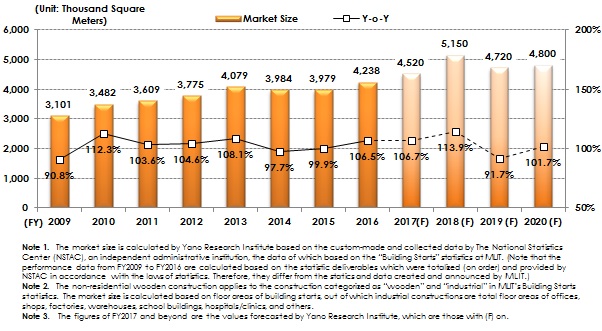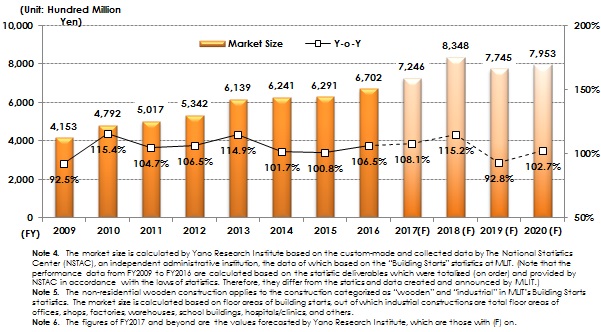No.1911
Non-Residential Wooden Construction Market in Japan: Key Research Findings 2018
Non-Residential Wooden Construction Market in Japan: Key Research Findings 2018
Yano Research Institute (the President, Takashi Mizukoshi) has conducted a survey on the domestic non-residential wooden construction market and has clarified the market trends and perspectives by FY 2020, trends of the market players, and the future outlook.


Market Overview
The domestic non-residential wooden construction market in FY2016 by floor area has risen to 4,238 thousand square meters, 106.5% of the size of the previous fiscal year, while the market size based on the estimated amount of construction expenses increased to 6,702,000 million yen, also 106.5% of the size of the previous fiscal year. The market size based on the Building Starts floor areas has been on the rise since FY2010 when “Promotion of Wood” Act, which is to promote more woods in public constructions, went into effect. In FY2014, wooden constructions in private sectors have decreased to scale down the entire market, stemming from sudden fall of consumer activities, which was the reaction after sudden rise of consumption just before increase of consumption tax. However, the market has been stable, ever since.
With regard to estimated amount of construction expenses, hike of labor cost due to recent shortage of construction workers and increasing use of cross laminated timber and fire-resistant structural building components to constructions have raised the unit price per square meter, boosting the market size since FY2010.
Noteworthy Topics
Currently, the characteristics of constructors developing non-residential wooden constructions can be categorized into the following two types:
1.Enterprises vigorously attempting to construct mid-to-high story buildings using fire-resistant structural building components.
2.Enterprises vigorously attempting to construct low story buildings using generally available woods for residence by means of conventional framework method or two-by-four method.
Because wooden mid-to-high story buildings need their structure to be fire resistant, the companies that fall into the former of the above characteristics such as Takenaka Corporation, Kajima Corporation, Sumitomo Forestry, and Shelter, have endeavored to develop their original fire-resistant building components. On the other hand, the latter companies like Sumitomo Forestry, Polus-Tech, and Mitsui Home Components have characteristics of having entered the market of non-residential buildings to use their knowhow that they had developed in the residential market.
Research Outline
2.Research Object: Businesses constructing non-residential wooden buildings (general constructors, house makers, laminated wood makers, architectural hardware makers, and etc.)
3.Research Methogology: Face-to-face interviews by the specialized researchers, supported by survey via telephone, collection and analysis of public information and documents. The market size is calculated by Yano Research Institute based on the custom-made and collected data by The National Statistics Center (NSTAC), an independent administrative institution, the data of which based on the “Building Starts” statistics at MLIT. (Note that the performance data from FY2009 to FY2016 are calculated based on the statistic deliverables which were totalized (on order) and provided by NSTAC in accordance with the laws of statistics. Therefore, they differ from the statics and data created and announced by MLIT.)
What is the Non-Residential Wooden Construction Market?
The non-residential wooden construction applies to the construction categorized as “wooden” and “industrial” in MLIT’s Building Starts statistics. The market size is calculated based on floor areas of building starts, out of which industrial constructions are total floor areas of offices, shops, factories, warehouses, school buildings, hospitals/clinics, and others.
Published Report
Contact Us
The copyright and all other rights pertaining to this report belong to Yano Research Institute.
Please contact our PR team when quoting the report contents for the purpose other than media coverage.
Depending on the purpose of using our report, we may ask you to present your sentences for confirmation beforehand.